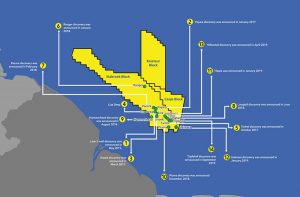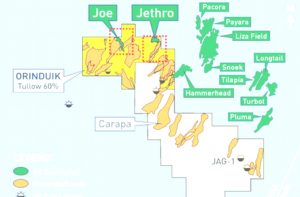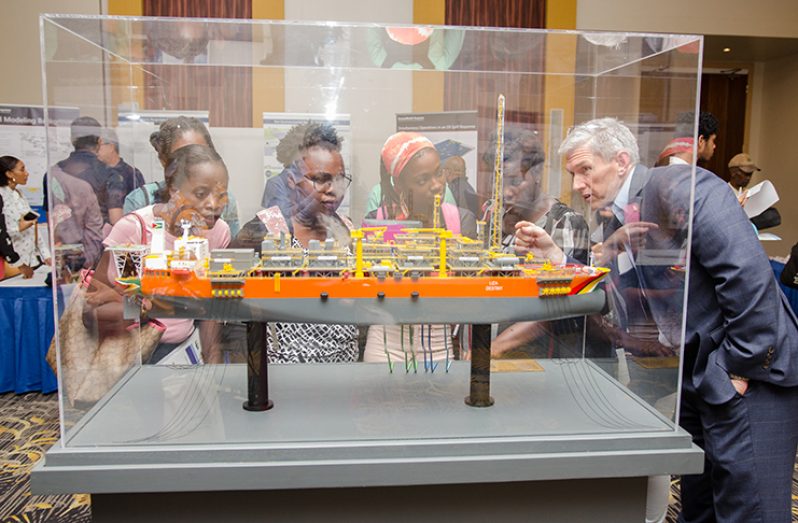By Lisa Hamilton
The journey towards ‘first oil’ in Guyana has been an exciting one with several discoveries along the way which have placed both Guyana and much of the rest of the world at the edge of their seat, eager to see the projected transformation finally play out.
In years past, Guyana was regarded as one of the poorest countries of South America even with a population of under 1 million but, today, it is projected to rise to the top of the continent’s rich list and up the general list of the richest countries in the hemisphere within the decade.
LIZA DISCOVERY
Guyana gained some of the world’s attention when it announced its first oil discovery at the Liza -1 well in the Stabroek Block on May 20, 2015. In a release ExxonMobil referred to the discovery as “significant” stating that it was encouraged after scores of previous wells dug had turned out dry. Guyana’s first Floating Production, Storage and Offloading (FPSO) vessel, the Liza Destiny has now commenced the production of oil aiming for up to 120,000 barrels of oil per day by 2020, with storage capacity of up to 1.6 million barrels. By 2025, it is expected to ramp up to 750,000 barrels daily which would see Guyana producing as much oil as Venezuela in just five years.
PAYARA DISCOVERY
The year 2017 was one of rapid successions in oil discoveries by ExxonMobil beginning with the Payara discovery announced in January 2017. Payara was ExxonMobil’s second oil discovery in the Stabroek Block which encountered 95 feet of high-quality, oil-bearing sandstone reservoirs.
Back in September 2019, Esso Exploration and Production Guyana Limited (EEPGL) submitted its Energy Information Administration (EIA) on the Payara Development Project to the Environmental Protection Agency (EPA). The project will see the drilling of up to 45 development wells which could take up to five years, with drilling beginning in 2020 and initial production by early 2023.
LIZA DEEP DISCOVERY
Also, in January 2017, the Liza Deep discovery was announced described that year as a “world-class” find which boosted the potential recoverable resource of 800 million to 1.4 billion oil-equivalent barrels. It confirmed that there was significant potential of high-quality oil in the Stabroek Block even as Exxon’s former CEO, Rex Tillerson told the Forbes Magazine that it was “…the equivalent of 1,400 Gulf of Mexico blocks.”

Just in May 2019, it was announced that the Liza Phase 2 Development has received ExxonMobil’s approval through funding and the new development will see some 30 wells being drilled and approximately 600 million barrels of oil as a result. Startup is pinned for mid-2022 with the aim of producing up to 220,000 barrels of oil per day with the help of the Liza Unity FPSO.
SNOEK DISCOVERY
Then in March 2017, the Snoek discovery was announced after the Snoek- 1 well was drilled in a new reservoir, encountering 82 feet of high-quality, oil-bearing sandstone reservoirs.
President of ExxonMobil Exploration Company, Steve Greenlee had stated: “The results from this latest well further illustrate the tremendous potential we see from our exploration activities offshore Guyana.”
TURBOT DISCOVERY
The US oil giant’s fifth discovery and last for 2017 was announced in October located at the Turbot- 1 well which encountered 75 feet of high-quality, oil-bearing sandstone. Located just 30 miles away from the Liza 1 well, the development was expected to further solidify Guyana’s potential as an oil producer.
RANGER DISCOVERY
The discoveries in 2018 exceeded the previous years as much of the world had begun to set their sights on Guyana as a possible petroleum powerhouse should the success continues.
In January 2018, Exxon’s sixth discovery at the Ranger – 1 well encountered 230 feet of high-quality, oil-bearing carbonate reservoir which would add to the more than 3.2 billion recoverable oil-equivalent barrels estimated total of the previous wells.
That year the Government of Guyana noted in a release: “The news of an additional find of this magnitude, particularly, at the start of the new year, can be seen as a further blessing and underscores the richness and diversity of Guyana’s natural resources.”
PACORA DISCOVERY
Then, just one month later, in February 2018, the Pacora discovery was announced as Exxon’s seventh discovery at the Pacora- 1 well encountering approximately 65 feet of high-quality, oil-bearing sandstone reservoir. By then it was common for countries around the world to report on the developments in Guyana expecting nothing less from the country’s basin even as the find that month would help bring Guyana production to more than 500,000 barrels per day.
LONGTAIL DISCOVERY
The Longtail discovery, announced in June 2018, at the Longtail – 1 well saw CEO John Hess stating: “We are very pleased with this eighth significant oil discovery, which reaffirms the remarkable exploration potential of the Stabroek Block.” It was drilled in a new reservoir, encountering approximately 256 feet of high-quality, oil-bearing sandstone reservoir and the estimates then were that Guyana had potential for some 4 billion oil-equivalent barrels all together.
HAMMERHEAD DISCOVERY
However, the country had cause once again to re-estimate upwards with the Hammerhead discovery announced in August 2018 which encountered approximately 197 feet high-quality, oil-bearing sandstone reservoir. Wood Mackenzie had suggested that year that ExxonMobil and Guyana had “hit jackpot” with the discovery which showed that the winning streak continued and with possibly no intention of stopping any time soon.
“Guyana has hit the jackpot,” Latin America Upstream Senior Research Manager, Maria Cortez told Wood Mackenzie, adding: “If this small South American nation with, a population of about 750,000, can properly manage the billions of dollars of revenue about to come its way, it may become the richest corner of the continent.”
PLUMA DISCOVERY
Taking the final slot for 2018, the Pluma discovery was announced in December 2018 as ExxonMobil’s 10th oil discovery which increased estimates of the discovered recoverable resource for the Stabroek Block to more than five billion oil-equivalent barrels. It was drilled in a new reservoir, encountering approximately 121 feet of high-quality hydrocarbon-bearing sandstone reservoir.

“Guyana is well poised to truly forge ahead in the 21st century. As a petro-development state we will, however, need to strategically invest in a people-centered and balanced manner, where we utilise our non-renewable resources for structural transformation and improving people’s lives in the short-term, while concomitantly providing the foundation to allow us to transition in the medium and long-term to a post-carbon economy,” Department of Energy (DE) Director, Dr. Mark Bynoe had stated.
TILAPIA AND HAIMARA DISCOVERIES
In February 2019, “double strike” were the words plastered across newspapers as ExxonMobil discovered oil in two wells – the Tilapia-1 and Haimara-1 wells — drilled only a short period before the discovery. This totaled Exxon’s discoveries to 12 with the Tilapia-1 well bearing 305 feet and the Haimara-1 207 feet of high-quality oil-bearing sandstone.
In the 2018 budget presentation just months ago, Finance Minister, Winston Jordan said that the discovery of very significant oil reserves has put Guyana at a critical point in its history. He assured citizens: “We are poised for rapid economic expansion, and our government is committed to pursuing economic and social policies conducive to equitable, sustainable and environmentally friendly growth.”
YELLOWTAIL DISCOVERY
The Yellowtail discovery was announced in April 2019 drilled in a new reservoir, encountering approximately 292 feet of high-quality oil-bearing sandstone. Dr. Bynoe said that month that the rate of the oil discoveries demonstrates the magnitude of Guyana’s natural resources. He welcomed the 13th announcement vowed that his department would monitor the developments closely to ensure that Guyanese reap the benefits.
JETHRO DISCOVER
In August 2019, Tullow Oil plc’s (Tullow) made its first oil discovery offshore Guyana at Jethro-1 well in the Orinduik Block. Although recent and initial analysis of the oil discovered in the well has shown that the finds are heavy crude with high sulphur content unlike the preferred light, low sulfur crude found in the Liza field, the company “remains optimistic” and “extremely confident about the future”.
JOE AND TRIPLETAIL DISCOVERIES
On September 16, “double Strike” was once again the catch phrase of news entities when two separate oil finds were announced by Tullow and ExxonMobil which said that the finds were of high-quality oil-bearing sandstone.
The Joe – 1 well located in the Orinduik Block encountered 52 feet of continuous thick sandstone while the Tripletail -1 well encountering approximately 108 feet of high-quality oil-bearing sandstone reservoir. The two finds brought the most recent total finds in Guyana to 16 in Guyana even as only a portion of the Stabroek and Orinduik Blocks have been explored and other blocks remain undrilled or unawarded.
In 2019, Guyana was ranked as the country with the second highest oil discoveries with Rystad Energy projecting that the Guyana-Suriname basin would continue to occupy headlines. It gives greater credibility to the United States (US) 2012 Geological Survey which ranked Guyana as having the second most attractive under-explored basin in the world, with a potential of 15.2 billion barrels of oil.



.jpg)









